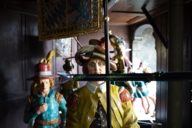
The Glockenspiel in the New City Hall on Marienplatz has been enchanting visitors and locals for over 100 years. What many do not know is that, every day, real manual work is needed, just as it used to be. Here, we have an exclusive look behind the scenes, in 10 pictures.
High Noon on the Munich Marienplatz. Everybody looks up at the tower of the Neues Rathaus. Then, finally, the Glockenspiel rings out: Shortly after 11am, the bayerische Ritter (the Bavarian knight) reliably removes the Lorraine rival off his horse using a lance; after this comes the animation dance of the Munich Schäffler (barrel-maker), followed by the cheers and the spectators’ applause.
The two scenes have lost none of their appeal in over 100 years. On the contrary; since the Summer Olympics in 1972, the figures also make their rounds at 12pm and, from March to October, also at 5pm. Does this all work at the touch of a button? We have brought pictures and amazing insights with us, gleaned from an exclusive visit behind the scenes of the Glockenspiel.
Daily at 11 am and at 12 pm, and from March to October additionally at 5 pm.
Every day at 9 pm the night watchman blows his horn while the angel blesses the Münchner Kindl.

The one who looks so introverted here, is a standard bearer from the entourage of the Bavarian Herzog (Duke) Wilhelm V, recognisable by the white-blue diamonds and the Bavarian lion on the flag. With its 1.40 metres, the copper figure only comes up to the chest of our photographer, Frank. However, we cannot say this for certain, because Frank had to crawl in on all fours to take the pictures! Wherever the light comes in, is where the figures go out to the Marienplatz, on the Glockenspiel stage. Outside, Wilhelm V and his wife, Renata of Lothringen (Lorraine), are already waiting for the courtiers to march in and for the knight tournament to begin.
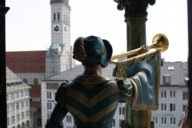
The tournament, on the occasion of the two-week-long wedding celebrations of Wilhelm and Renata, actually did take place on the Marienplatz in the spring of 1568. When the couple left the Frauenkirche (Our Lady’s Church) after the wedding, snow is said to have lain. The figures in the town hall tower defy wind and weather like this herald for all of 364-days-a-year. Only on Good Friday is the Glockenspiel silent all day. No delays are allowed. The Glockenspiel team is on the ball – if they weren’t, even after two minutes, the first tourist would be standing on the Rathaus gatekeeper’s doorstep! Part three of the Glockenspiel, which is performed every evening at 9pm, is a real insider tip. At this time, night-watchmen and guardian angels put the Münchner Kindl (child monk) to bed in the right lateral bay window of the Glockenspiel to the sounds of Johannes Brahms’ Wiegenlied (lullaby).
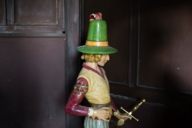
On our visit, the entire court makes a bella figura, like this page with his grassy hat and red jerkin. Only recently have all the figures been removed and given a new coat of paint; the ‘Schäffler’ one level lower has, too. Unfortunately, we do not have a picture of it. Frank would have had to abseil outside the tower to photograph it up close. We were not prepared for that, but we would like to briefly tell the story here. The Fassmacher (barrel-maker) guild is called the ‘Schäffler’. After a severe plague epidemic in 1517, they were the first to risk venturing out onto the streets to cheer the people up with their dancing. The dance of the Münchner Schäffler is still performed every seven years (next time is in 2026) by real dancers in many places in the city.
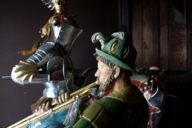
The new sparkling armour is of no use to the Lothringer Ritter in the background. The 2.10 metre high rider figure with the red and white pelmet is the eternal loser. In the second round, he will fall off the horse and be manually picked up by an employee at the very end of the Glockenspiel – this is where the ten-person team comes into play who ensure a smooth run all the year round. After all, it is not just the knight which has to be helped back onto his horse. The electro-mechanical Glockenspiel works almost exactly as it did when it was installed and Munich had only 498,503 inhabitants although, today, it is powered by solar power. Considering that it has been in operation for over 100 years, it runs very well, but it does need attentive care and maintenance: Its individual parts have to be ground and lubricated, contacts polished, screws need to be retightened, little wheels, gears and stops regularly replaced.
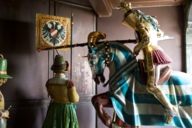
“The best thing that can happen is that something breaks down”, explains a member of staff who has been on board for several years and is very proud that he helps to keep Munich’s #1 visitor-magnet running. “Error culture”, or even “error-friendliness” are not foreign words in the New Town Hall Tower. Any disruptions in its operation aids the understanding of how the Glockenspiel works. Any errors that occur are valuable work experience for the team – it takes years to get to know the Glockenspiel really well. A beginner has to learn how to control the processes precisely to the second. In order for the Bavarian knight and all the other protagonists to arrive punctually, a precise sequence must be followed. At the beginning, the employee actually presses a start button. Gradually, he or she then manually switches the songs and then, in accordance with a defined choreography, he or she adds the individual figures and groups of figures.
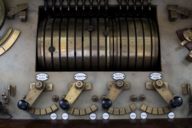
The control centre on the fifth floor of the tower occupies surprisingly little space. Externally, it resembles a display case from my grandmother’s living room. Under the glass are the shift levers with which the Glockenspiel is operated. From left to right in the picture, you can see the lever for the knight tournament, for the accompanying music during the day, and for the bedtime music for the Münchner Kindl. The ‘Hahn’ (cockerel), who crows at the end of the Glockenspiel and the ‘Hanswurst’, an ensemble member of the Schäffler, are switched on by hand, too. At the end of each performance, the applause of the crowd on Marienplatz is ensured – it is the same as a pilot receives when he makes a great landing.
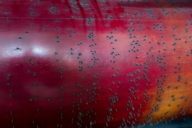
On the 8th floor, approximately at the height of the observation deck but, unlike this, inaccessible to visitors, the music plays or rather, here the conditions are created for the bells on the top-floor to musically accompany the scenes. When the corresponding switch is turned on three storeys down at the main switch, a purple cylinder, which is partially covered with small metal pins, begins to rotate again and again here. Thanks to the arrangement of the pins, the polyphonic playing styles are programmed. The principle is the same as with one of these little miniature barrel organs, which are manually driven by a crank. Each pin triggers a bell strike via a switch relay.
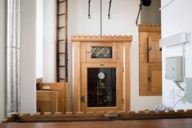
At the bottom left of the cupboard, the doors are open, and there are five more cylinders there. Cylinder number 3 was playing at that time; its four tunes entitled ‘Loreley’, ‘Preisend mit viel schönen Reden’, ‘Schäfflertanz Part 1’ and the ‘Wendelstein-Lied’ can be heard in March and August. Overall, the Glockenspiel has six cylinders with a total of 22 different melodies in its repertoire which are predominantly from folk songs dating back to the beginning of the 20th century. The four pieces of music on cylinder 6 are only played during Advent. Even after all these years, the staff still like to hear the melodies and they actually hum them in secret. Attempts to deviate from this music programme and to record piano music, for example, were met with a distinct lack of enthusiasm. An attempt to win the composer, Carl Orff, to write a composition specifically for the Glockenspiel in honour of the 800th anniversary of the city in 1958 also failed.
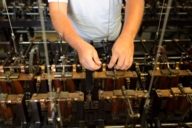
Here, we are on the 10th floor. Up here, it is cold and draughty and above us there is only the belfry with its 43 bells, as well as a small viewing platform, which the employees sometimes use to catch their breath because, in the so-called machine room, it smells like a car repair workshop. Opposite us is the nice colleague, who explains to us in all the fascinating detail, what happens next when the impulses from the music cylinder arrive up here from the 8th floor. To do this, he manually manipulates one of the 44 well-oiled musical mechanisms (44 of them for 43 bells, one is a substitute). Here, by means of chains and a gear mechanism, the pulling devices for the bells are set in motion which eventually ensure that the clapper makes the bell ring.
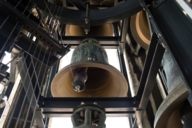
The Glockenspiel does not always sound harmonious, it is exposed to the elements, and the old technology has its pitfalls. For the city’s 850th anniversary in 2008, all the bells were removed, cleaned and refurbished, reinstalled, sound revised and tuned. The people of Munich donated generously to this. Nevertheless, jarring notes can always arise when the metal warps or the screws loosen due to the heat or cold. If one bell is not working properly, it is still within the tolerance range, but if several bells are missing (which most of the spectators may not even notice), the limit is exceeded for the Team Glockenspiel staff. If the Glockenspiel does not sound right, the schnitzel (breaded escalope) in the canteen no longer tastes as good as it should. With a great deal of hard work and patience, they then tackle the problem and solve it – 364-days-a-year, in all weathers and to the delight of guests to Munich from all over the world.
The Glockenspiel is a must, the ascent to the viewing gallery in the town hall tower voluntary. High above the hustle and bustle of the Marienplatz and the roofs of the old town, one has a clear view over to the onion domes of the neighbouring Frauenkirche from here. To the north, you can see all the way to the tent roofs of the Olympic Park and to the Allianz Arena. To the south, the view sweeps over the green of the Isar floodplains and the forests into the surrounding countryside – when the view is clear, one can ever see as far as the Alps.
By the way, in addition to the Glockenspiel and the New Town Hall Tower, an exclusive tour of the New Town Hall itself is also well worth doing: Here, the official guides of the state capital show and explain what deeply moves Munich. 90 minutes all about politics and football gods, Gothic and ‘purse-washing’, Monachia and the ‘Metzgersprung’ (in which newly-qualified butchers jump into a fountain) in quite possibly the most beautiful fake medieval building north of the Alps. Our author participated in the tour and was quite delighted!